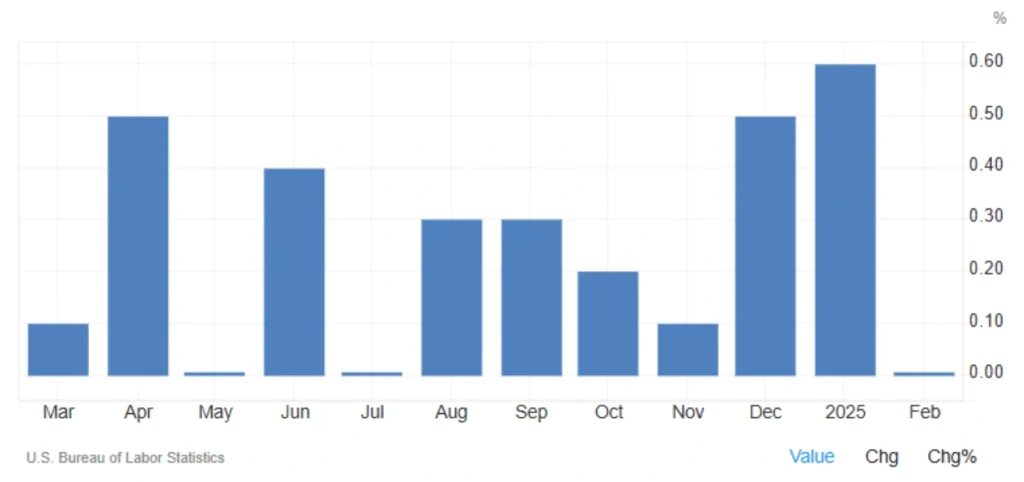
U.S. Producer Price Index (PPI) Remains Stable in February 2025
The latest economic data shows that the U.S. Producer Price Index (PPI) remained unchanged in February 2025, defying market expectations of a 0.3% increase. This report offers valuable insights into inflation trends and potential Federal Reserve policy shifts.
Understanding the February 2025 PPI Data
Key Takeaways
No change in PPI: The index remained stable compared to January, despite forecasts of a 0.3% rise.
Lowest monthly change in seven months: February marked the smallest fluctuation since mid-2024.
Service prices fell 0.2%: This decline is the largest since July 2024.
Wholesale machinery and vehicle prices dropped 1.4%: This sector saw the sharpest decline.
Goods prices increased by 0.3%: However, two-thirds of this rise was due to a staggering 53.6% surge in egg prices.
Annual producer inflation fell to 3.2%: Lower than the 3.3% forecast and down from 3.7% in January.
Read More: The US Government’s Bold Move into Crypto
Why Does the Producer Price Index Matter?
The PPI measures changes in the prices that producers receive for goods and services. It serves as a leading indicator for consumer inflation, helping economists and policymakers assess inflationary pressures before they reach consumers.
PPI vs. CPI: What’s the Difference?
PPI (Producer Price Index): Reflects price changes at the producer and wholesale levels.
CPI (Consumer Price Index): Measures how these price changes impact consumers directly.
Why Was February’s PPI Lower Than Expected?
Several factors contributed to the weaker-than-expected PPI reading:
- Declining service prices, particularly in wholesale automotive and consumer goods.
- Limited goods price increases, despite the surge in certain categories like eggs.
- Weaker demand in industries like apparel and chemicals.
Impact on Inflation and Federal Reserve Policy
A stable or declining PPI indicates reduced inflationary pressure in the supply chain. This could lead to lower consumer inflation (CPI) and influence the Federal Reserve’s interest rate decisions in the coming months.

Market Reactions and Future Scenarios
A lower PPI may encourage the Fed to consider rate cuts cautiously.
However, inflation remains elevated, so an immediate shift in policy is unlikely.
Potential Market Effects
Bond yields may decline due to reduced inflation concerns.
Stock markets could benefit, particularly consumer and technology sectors that thrive in lower-inflation environments.
Future Scenarios to Watch
Optimistic Outlook: If PPI continues to decline, the Fed may adopt a more accommodating monetary policy.
Challenging Scenario: If goods prices rebound, consumer inflation could rise, forcing the Fed to maintain a restrictive stance.
Investment and Trading Strategies
For Long-Term Investors
Focus on inflation-sensitive stocks like consumer and tech sectors.
Monitor Federal Reserve policy shifts closely.
Diversify with bonds and inflation-hedging assets.
For Short-Term Traders
Track inflation reports and market reactions.
Implement stop-loss strategies to manage volatility.
Follow the U.S. dollar’s performance in global markets.
For Commodity and Energy Investors
Keep an eye on raw material prices, including steel, energy, and agricultural products.
Assess how inflation data impacts global commodity markets and currency values.
Conclusion: What Lies Ahead?
The February 2025 PPI report signals stable inflationary pressures, with lower service costs offsetting modest goods price increases. Investors and traders should keep a close watch on upcoming economic data and Federal Reserve policy adjustments to navigate potential market shifts effectively.
This version maintains a professional tone, clear structure, and a fluent flow while enhancing readability. Let me know if you’d like any refinements!
Share
Hot topics

How to Invest in Forex and Buy Stocks?
Investing has become one of the most controversial topics. Thanks to social media influencers promoting a particular trading platform or ordinary people trying to become financially independent. It seems like...
Read more




Submit comment
Your email address will not be published. Required fields are marked *